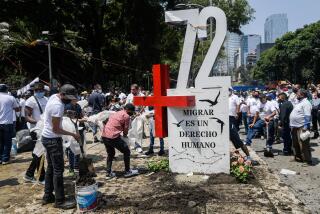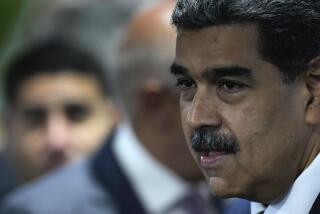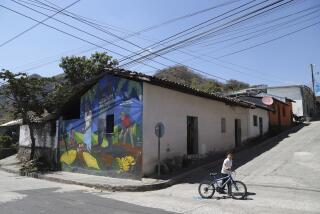20 Years Later, Salvadorans Have to Answer for Nuns’ Murders
WEST PALM BEACH, Fla. — Stopped by national guardsmen at a rural roadblock, the women were abducted, raped and murdered, each executed with a rifle shot to the head.
The December 1980 killings of Maryknoll nuns Ita Ford and Maura Clarke, Ursuline Sister Dorothy Kazel and lay missionary Jean Donovan took place near the start of El Salvador’s 12-year civil war, a conflict in which more that 75,000 civilians died.
Nearly two decades after the deaths put a U.S. face on Central America’s turmoil, two men who served as El Salvador’s top military officials are on trial in federal court here, answering civil accusations that they were responsible for the murders and helped cover them up.
“There were abuses by the armed forces, and that cannot be denied,” former Gen. Jose Guillermo Garcia, El Salvador’s former defense minister, testified last week.
But Garcia told jurors that he was helpless to stop the abuses. When he demanded investigations, he said, the actions were always explained by subordinates as “military operations.”
The testimony last week by Garcia and Carlos Vides Casanova, former director of the national guard, marked the first time that either man has been questioned under oath about the killings.
Vides Casanova, 62, also denied any responsibility for the slayings. Five guardsmen were convicted in El Salvador of murder in 1984.
The reason that Garcia and Vides Casanova are in court--and no longer anonymous Florida retirees--is a lawsuit brought by relatives of the four women. Under the rarely used federal Torture Victims Protection Act, the families are seeking unspecified punitive and compensatory damages against both men.
For relatives of the slain churchwomen--many of whom have been in court since jury selection began Oct. 9--the trial has been wrenching. After projecting huge photos of the victims on a courtroom wall, attorney Bob Montgomery opened the case by describing them as targets of military death squads because of their outspoken criticism of the government’s human rights abuses.
“The persons who were in control and had the ability to stop it didn’t do so,” said Montgomery, who is representing the victims’ families.
The trial has reopened the book on U.S. involvement in Central America, especially in El Salvador, where the Reagan and Bush administrations spent $7 billion to help defeat left-wing guerrillas. In addition to the tens of thousands killed during the civil war, thousands more were driven into exile, many to Southern California.
Questioning America’s Role as ‘Secure Haven’
The trial has also turned a spotlight on America’s role as a sanctuary for those suspected of war crimes and human rights abuses in various world trouble spots.
“The message should be that the U.S. is not going to be a secure haven,” said attorney Robert O. Varenik of the Lawyers Committee for Human Rights. “And this case points out the need for appropriate standards for admitting people like this.”
A bill that would exclude immigrants convicted of political killings and torture, called the Serious Human Rights Abusers Accountability Act, is pending in Congress. With or without that legislation, however, “we are looking to hold these men liable, and get their immigration status revoked,” said William Ford, a brother of Ita Ford.
“These defendants are in the position they are in because my sister and three others were murdered. They are responsible for those deaths.”
The defendants’ attorney, Kurt R. Klaus Jr., reserved his opening statement for later in the trial, and he has yet to present any defense. He is expected to recall Garcia and Vides Casanova to testify this week before the case goes to the jury.
A 1993 U.N. Truth Commission report concluded that Garcia and Vides Casanova organized and directed a cover-up of the four slayings, and thousands of others.
At issue here, U.S. District Judge Daniel T.K. Hurley explained to the 10-member jury, is “command responsibility.” What did Garcia and Vides Casanova know, and what should they have known?
In a full day on the witness stand, Garcia said that in the early 1980s, he knew little of the widespread killings and torture being carried out by uniformed soldiers. He said he now knows that troops under his command were involved in such atrocities--the 1981 massacre of El Mazote, in which 600 men, women and children were killed; the machine-gunning of wounded hospital patients; the herding of civilians to their deaths at the Rio Sumpul--but was uninformed at the time they occurred.
Asked by plaintiffs’ lawyer Robert G. Kerrigan why he did not order an investigation, Garcia said he had “no means.” “The judiciary department [of the military] was just one person,” he added.
Vides Casanova also acknowledged that abuses by the military, including national guard troops he commanded, were rampant. He said he did all he could to curb the violence. But apart from ordering his troops to behave, he offered no examples of how he responded to reports of atrocities.
Both men described a pervasive culture of violence that encouraged lawlessness on the part of soldiers and police.
Also testifying last week was Robert E. White, U.S. ambassador to El Salvador at the time the churchwomen were slain. White said that when he notified Garcia of the women’s disappearance the day before their bodies were unearthed from a common grave, the military chief asked whether they were wearing nuns’ habits.
“That was a blow to me,” White said. “I felt the question indicated he knew the nuns had been killed and he was going to use the defense that the women were not nuns in good standing.”
Salvadoran military officials were known to distinguish between “good” nuns, who wore traditional habits, and what they considered “bad” nuns who dressed more casually and were believed to be sympathetic to leftist guerrillas.
White also asserted that he was fired from his post in late 1980 by the incoming Reagan administration after refusing to give former Secretary of State Alexander M. Haig certification that the Salvadorans were making progress in investigating the women’s deaths. “Washington’s idea of an investigation also had more of a dream quality,” said White, now president of the Center for International Policy, a Washington think tank.
The relatives sued Garcia and Vides Casanova in May 1999 after investigators working for the New York-based Lawyers Committee found the men living in retirement with their families, Garcia near Fort Lauderdale, and Vides Casanova north of Daytona Beach. Both men receive pensions from the Salvadoran government.
Evidence Includes Interviews, Document
Among evidence submitted in the trial are prison interviews with four of the five convicted guardsmen, and a now-unclassified document that the U.S. State Department termed “Special Embassy Evidence.”
The document is a transcript of a secretly recorded interview with Luis Colindres Aleman, the national guardsman who led the unit that carried out the killings. For nearly two decades, U.S. officials have pointed to the Special Embassy Evidence as proof that Colindres Aleman acted on his own in ordering the executions. But Colindres is never asked by his military questioner whether higher-ups gave him orders to kill the churchwomen, according to the transcript.
Colindres and the four national guardsmen he commanded were sentenced to 30 years in prison in 1984. But in 1998, Colindres and two of the others were released from an El Salvador prison under a program designed to free up jail space.
*
Times researcher Anna M. Virtue contributed to this story.
More to Read
Sign up for Essential California
The most important California stories and recommendations in your inbox every morning.
You may occasionally receive promotional content from the Los Angeles Times.










